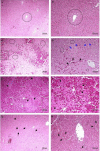Protective effects of 2-methoxycinnamaldehyde an active ingredients of Cinnamomum cassia on warm hepatic ischemia reperfusion injury in rat model
- PMID: 32133057
- PMCID: PMC7043872
- DOI: 10.22038/IJBMS.2019.13987
Protective effects of 2-methoxycinnamaldehyde an active ingredients of Cinnamomum cassia on warm hepatic ischemia reperfusion injury in rat model
Abstract
Objectives: Hepatic ischemia/reperfusion injury (IRI) is one of the major causes of hepatic failure during liver transplantation, trauma, and infections. The present study investigated the protective effect of intra-portal administration of 2-methoxycinnamaldehyde (2-MCA) on hepatic IRI in rats.
Materials and methods: Twenty-four rats were equally divided into four groups; 1) sham group, (no IRI or transfusion), 2) Hepatic IRI (60 min ischemia + 120 min reperfusion, 3) Hepatic IRI+ NS (IRI + normal saline), 4) Hepatic IRI+2-MCA, (IRI + 2-MCA). In groups 3 and 4, 1 ml/kg normal saline and 2-MCA were administered slowly into the vein of the left lateral and median lobes of the liver 10 min before induction of hepatic reperfusion (upper the site of clumping), respectively. The harvest time points were at 2 hours post-reperfusion in all groups.
Results: Histologically, cell death, degenerative changes, sinusoidal dilatation, congestion, hemorrhage, and infiltration of inflammatory cells were observed in IRI group, while these pathological changes were attenuated in the 2-MCA administrated group. The level of alanine transaminase, aspartate transaminase, tumor necrosis factor- α and interleukin-6 in serum and hepatic malondialdehyde were significantly increased by IRI, and 2-MCA administration reduced all these markers. In addition, caspase-3 and nuclear factor κB (NF-κB) expression were investigated immunohistochemically. Administration of 2-MCA considerably decreased caspase-3 positive cells and NF-κB activity in comparison with IRI group.
Conclusion: As a conclusion, in situ administration of 2-MCA protects against hepatic IRI via anti-inflammatory, and anti-apoptotic properties.
Keywords: Ischemia reperfusion injury; Liver; Oxidative stress; Rat 2-Methoxycinnamaldehyde.
Figures






Similar articles
-
2-methoxycinnamaldehyde from Cinnamomum cassia reduces rat myocardial ischemia and reperfusion injury in vivo due to HO-1 induction.J Ethnopharmacol. 2012 Jan 31;139(2):605-15. doi: 10.1016/j.jep.2011.12.001. Epub 2011 Dec 9. J Ethnopharmacol. 2012. PMID: 22179023
-
Protective effect of Coriandrum sativum extract against inflammation and apoptosis in liver ischaemia/reperfusion injury.Folia Morphol (Warsz). 2021;80(2):363-371. doi: 10.5603/FM.a2020.0060. Epub 2020 Jun 3. Folia Morphol (Warsz). 2021. PMID: 32488856
-
Aucubin Attenuates Liver Ischemia-Reperfusion Injury by Inhibiting the HMGB1/TLR-4/NF-κB Signaling Pathway, Oxidative Stress, and Apoptosis.Front Pharmacol. 2020 Sep 8;11:544124. doi: 10.3389/fphar.2020.544124. eCollection 2020. Front Pharmacol. 2020. PMID: 33013386 Free PMC article.
-
Responses of hepatic sinusoidal cells to liver ischemia-reperfusion injury.Front Cell Dev Biol. 2023 Apr 4;11:1171317. doi: 10.3389/fcell.2023.1171317. eCollection 2023. Front Cell Dev Biol. 2023. PMID: 37082623 Free PMC article. Review.
-
Targeting the Hepatic Microenvironment to Improve Ischemia/Reperfusion Injury: New Insights into the Immune and Metabolic Compartments.Aging Dis. 2022 Jul 11;13(4):1196-1214. doi: 10.14336/AD.2022.0109. eCollection 2022 Jul 11. Aging Dis. 2022. PMID: 35855339 Free PMC article. Review.
Cited by
-
p53 Rather Than β-Catenin Mediated the Combined Hypoglycemic Effect of Cinnamomum cassia (L.) and Zingiber officinale Roscoe in the Streptozotocin-Induced Diabetic Model.Front Pharmacol. 2021 May 13;12:664248. doi: 10.3389/fphar.2021.664248. eCollection 2021. Front Pharmacol. 2021. PMID: 34054538 Free PMC article.
-
Metabonomics Study on Naotaifang Extract Alleviating Neuronal Apoptosis after Cerebral Ischemia-Reperfusion Injury.Evid Based Complement Alternat Med. 2022 Mar 14;2022:2112433. doi: 10.1155/2022/2112433. eCollection 2022. Evid Based Complement Alternat Med. 2022. PMID: 35321499 Free PMC article.
-
Network pharmacology combined with molecular docking and experimental validation to explore the potential mechanism of Cinnamomi ramulus against ankylosing spondylitis.Ann Med. 2023;55(2):2287193. doi: 10.1080/07853890.2023.2287193. Epub 2023 Nov 29. Ann Med. 2023. PMID: 38019769 Free PMC article.
References
-
- Kim JS, He L, Lemasters JJ. Mitochondrial permeability transition: a common pathway to necrosis and apoptosis. Biochem Biophys Res Commun. 2003;304:463–470. - PubMed
LinkOut - more resources
Full Text Sources
Research Materials
Miscellaneous
